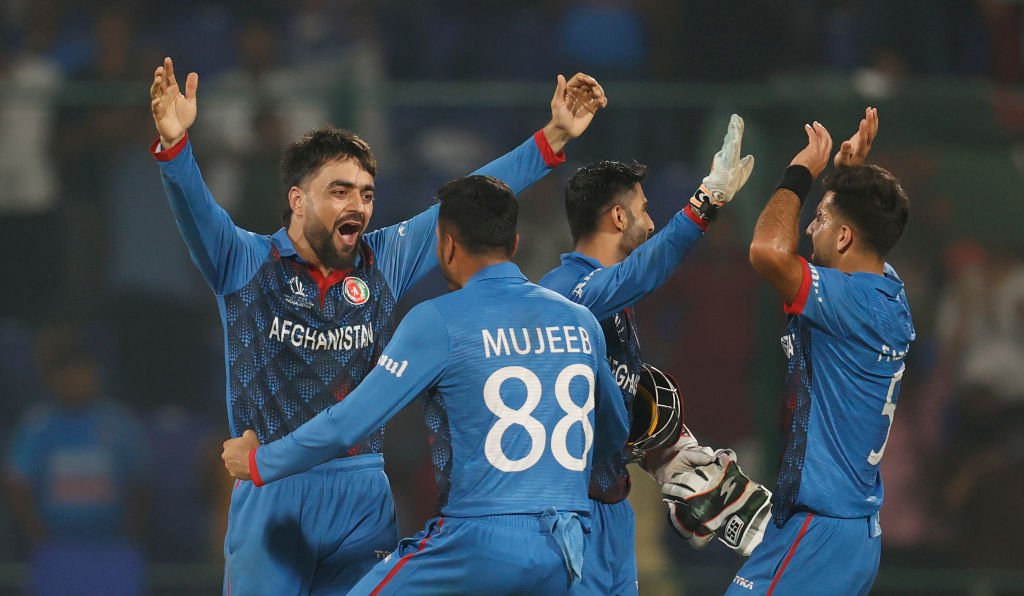
Afghanistan faced off against Bangladesh in a closely contested ODI match that saw star batter Mohammad Nabi and captain Hashmatullah Shahidi put up a fighting total of 235 runs. However, Bangladesh’s bowlers, led by Mustafizur Rahman and Taskin Ahmed, executed a well-coordinated strategy to hold the Afghan team in check. Nabi’s explosive 84-run innings and Shahidi’s steady 52 showcased their resilience, yet the disciplined approach of Bangladesh’s bowlers ultimately tipped the scales.
Afghanistan’s Steady Start and Middle-Order Resilience
After winning the toss, Afghanistan elected to bat, hoping to post a competitive score. The innings began cautiously, with Bangladesh’s bowlers initially containing the Afghan openers. Afghanistan’s top order faced a solid bowling attack from Bangladesh, which included strategic overs by Taskin Ahmed and Mustafizur Rahman. As the early overs progressed, Afghanistan managed to maintain wickets but struggled to accelerate the run rate due to disciplined field placements and pressure from Bangladesh’s bowlers.
However, Mohammad Nabi entered the game with a clear intent to shift momentum. Known for his ability to stabilize innings while also finding boundaries, Nabi was instrumental in elevating Afghanistan’s total. His 84 runs off 62 balls were laced with aggressive stroke play, including a series of sixes that lifted Afghanistan’s innings during critical stages. Shahidi, on the other hand, played a more patient knock of 52, focusing on building a stable partnership to prevent collapses.
Their partnership served as the backbone for Afghanistan, as they recovered from a slow start to post a defendable total. Nabi’s partnership with Shahidi not only provided stability but also helped accelerate the innings at a critical juncture, giving Afghanistan a fighting chance against Bangladesh’s seasoned bowlers.
Bangladesh’s Bowling Unit Steps Up
Bangladesh’s bowling lineup, however, remained focused, ensuring that the score did not get out of hand. Taskin Ahmed and Mustafizur Rahman, in particular, led the charge. Mustafizur’s experience and precision in his deliveries restricted Afghanistan’s scoring opportunities, especially during the death overs. He utilized his signature slower deliveries and cutters, making it difficult for Afghan batters to find consistency in their shots.
Taskin Ahmed complemented Mustafizur effectively by targeting key Afghan batsmen with pace and accuracy. Taskin’s ability to generate bounce and movement troubled Afghanistan’s middle order, and his line and length made scoring boundaries challenging. Together, Taskin and Mustafizur took pivotal wickets that disrupted Afghanistan’s momentum, particularly after the dismissal of Nabi and Shahidi, who were the mainstay of the innings.
The combined efforts of Bangladesh’s bowling unit were evident in their ability to keep Afghanistan’s lower order under wraps. Despite Nabi’s and Shahidi’s contributions, Bangladesh maintained composure, setting up a chaseable target for their batters.
Nabi’s Knock: A Spark of Brilliance Amid Challenges
Mohammad Nabi’s 84 runs came at a time when Afghanistan needed a spark to build their innings. His powerful shots and risk-taking ability allowed Afghanistan to post a respectable score. Nabi’s performance highlighted his experience and skill, especially as he countered the disciplined bowling attack of Bangladesh with poise and aggression.
Nabi’s innings included calculated shots aimed at maximizing scoring opportunities without compromising his wicket. His innings demonstrated the balance between aggression and caution, which was essential to preventing collapses and ensuring that Afghanistan reached a competitive total. Nabi’s partnership with Shahidi was instrumental, with both players complementing each other’s styles and forming a synergy that temporarily shifted control in Afghanistan’s favor.
Hashmatullah Shahidi’s Steady Captaincy and Contribution
Afghan skipper Hashmatullah Shahidi showcased his leadership through both his calm demeanor on the field and his steady half-century. His 52 runs were essential in stabilizing Afghanistan’s innings, especially in the face of early breakthroughs by Bangladesh. Shahidi’s approach to maintaining a patient knock allowed him to anchor one end while Nabi took on the role of aggressor.
Shahidi’s knock highlighted his adaptability and situational awareness, as he adjusted his game to accommodate Nabi’s aggressive stroke play. Together, they provided the stability needed for Afghanistan to build their total after a difficult start. Shahidi’s leadership on the field, combined with his tactical decision-making, was evident as he guided his team through challenging phases, particularly against Bangladesh’s disciplined attack.
Bangladesh’s Chase and Final Thoughts
Bangladesh’s calculated chase mirrored their disciplined bowling performance. Led by consistent batting and partnerships, they pursued the target with caution, not allowing Afghanistan’s bowlers to settle into a rhythm. Bangladesh’s top-order batters played crucial roles in securing the win, reflecting their experience and composure.
This match showcased the strength of both teams and highlighted areas for improvement. For Afghanistan, finding support for star performers like Nabi and Shahidi in the batting order remains essential to secure higher totals. Bangladesh, on the other hand, will look to maintain their momentum with a balanced approach in both bowling and batting.

